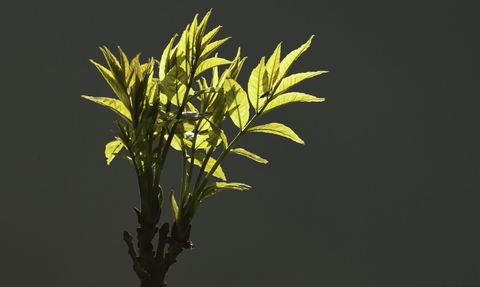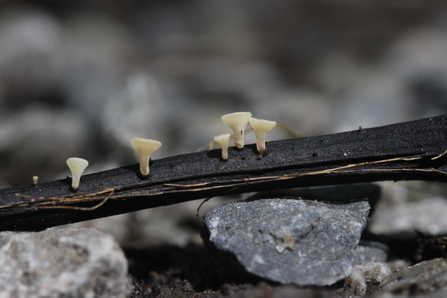
Ash leaves (c) Mark Hamblin/2020VISION
Ash Dieback
Ash dieback is a fungal disease that affects ash trees and is expected to kill up to 90% of the ash trees in the UK.
Ash dieback arrived in the UK in 2012 and has spread across the county. Ash dieback is caused by a fungus which blocks water transport in the tree, leading to scratches in the bark, leaf loss and eventually killing the tree from the outermost branches inward. The disease weakens the trees to the point where they will eventually drop limbs, collapse or fall. The economic cost of the disease to the UK is predicted to reach up to £15 billion.
Ash dieback in Hertfordshire and Middlesex
We are assessing the health of ash trees across all of our nature reserves, and our response to the disease requires a significant investment in time and resources.
Affected trees near to footpaths or along roads pose a risk to public safety because of the risk of falling branches or collapsing trees. To keep our visitors and property safe, we are undertaking a targeted programme of works on our nature reserves. Some trees need to be felled immediately because they are already dead or dying and public paths may have to be temporarily closed. The loss of these trees will result in unavoidable changes to some of our nature reserves, but the work is being carefully timed to minimise the impact on wildlife such as nesting birds.
We will continue to monitor the reserves in our care over the coming years. The symptoms are often easier to spot in mid-late summer, when a healthy ash should be in full leaf. It becomes much harder in autumn, when leaves are naturally changing colour and falling.

Ash dieback fungus Hymenoscyphus fraxineus (c) Bjorn S
The end of ash trees?
Ash dieback will not be the end of native ash trees in the UK, but it will have an enormous impact on our wild landscapes. Evidence suggests that a small proportion of trees are resistant to ash dieback, so where it is safe to do so we will allow nature to take its course in the hope that these trees will eventually help the ash population to recover.
What you can do to help
Ash dieback is primarily spread on the wind but visitors to affected sites can help to reduce the spread of the fungus by brushing soil, mud, twigs, leaves and other plant debris off their footwear and wheels - including the wheels of cars, bicycles, mountain bikes, baby buggies and wheelchairs - before leaving the site. They should then wash these items at home before visiting another similar site.
Ash Dieback FAQs
What is ash dieback?
Ash dieback is a disease that affects ash trees, caused by a fungus called Hymenoscyphus fraxineus. The fungus blocks water transport in the tree, leading to lesions in the bark, leaf loss and the dieback of the crown.
Ash dieback fungus is believed to have originated in Asia. It was first discovered in Europe in Poland in 1992, and is now found widely across the continent. The first confirmed case in the UK came in 2012, since when it has spread across England and to Scotland, Wales, Northern Ireland, and the Isle of Man.
What are the symptoms of ash dieback?
The main symptoms of ash dieback are:
- Dead branches
- Blackening of leaves which often hang on the tree
- Discoloured stems often with a diamond-shape lesion where a leaf was attached
Trees may eventually drop limbs, collapse or fall. The symptoms are often easier to spot in mid-late summer, when a healthy ash should be in full leaf. It becomes much harder in autumn, when leaves are naturally changing colour and falling.
Once a tree is infected the disease is usually fatal, either directly, or indirectly by weakening the tree to the point where it succumbs more readily to attacks by other pests or pathogens, such as honey fungus. These secondary pathogens can cause butt or root rot, leading to the tree falling.
How does ash dieback spread?
The disease can spread locally (over tens of miles) by wind dispersal. The reproductive stage of the fungus grows on the previous year's fallen leaves, producing fruiting bodies that release spores between June and September. These spores are dispersed by the wind and settle on the leaves of healthy trees. If a healthy tree receives a high enough dose of spores, it too will become infected.
Over longer distances, the disease may be spread by the movement of infected ash plants.
Visitors to sites where ash dieback is present can help to reduce the spread by brushing soil, mud, twigs, leaves and other plant debris off their footwear and wheels - including the wheels of cars, bicycles, mountain bikes, baby buggies and wheelchairs - before leaving the site. They should then wash these items at home before visiting another similar site.
Why do trees need to be felled?
Diseased ash trees can become extremely unstable and are at an increased risk of dropping limbs or complete collapse. The Trust has a duty of care to ensure that visitors, staff, volunteers and our neighbours are safe on or adjacent to land which the Trust is responsible for. As such it is inevitable that as trees become unsafe a significant number will need to be felled. This will be necessary on an annual basis until the disease has run its course.
Will you leave some infected trees in place?
Yes. We will only remove trees which are at risk of causing injury to the public, our volunteers, staff or our neighbours. All other infected trees will be retained. It is possible that some trees will survive the fungus and recover to good health. These trees could produce new generations of tolerant ash trees for the future.
What about the wildlife that uses the trees?
In any ash removal, we will consider the needs of protected species, such as bats, along with other woodland wildlife. This will include actions such as:
- Only felling in areas deemed ‘high risk’ - such as adjacent property boundaries, roadsides and around carparks and benches. Across the majority of reserves ash will be left to die naturally.
- The closure of permissive paths will be considered in order to increase areas where felling is not required.
- Phasing works over a number of years, rather than in a single operation, when safety requirements allow.
- ‘Soft-felling’ of trees with high bat roost value, where tree limbs are cut and left grounded over night to allow any bats to make their way out.
- Ensuring felling takes place in the winter so that it has limited negative impact on species.
In some woodlands the loss of ash may provide an opportunity to improve woodland structure, create open space, diversify tree species and increase dead wood, an important habitat for groups such as fungi and invertebrates.
Can you re-plant to replace felled trees?
The most sustainable way to replace felled trees is to allow the trees and shrubs to regenerate naturally. A small percentage of ash trees will be resistant to the disease and healthy trees will be retained to allow the seed from these trees to naturally regenerate. The loss of ash from woods may allow other native tree species to benefit, colonising newly created open areas.
What can we do to make sure our woods are more resilient in the future?
We will retain as many potentially tolerant ash trees as possible. Newly created open areas will allow natural regeneration by seed from healthy ash trees, as well as other native species.
